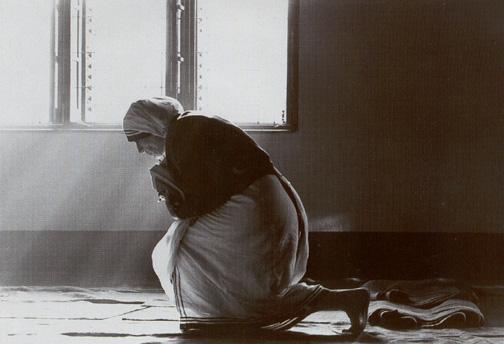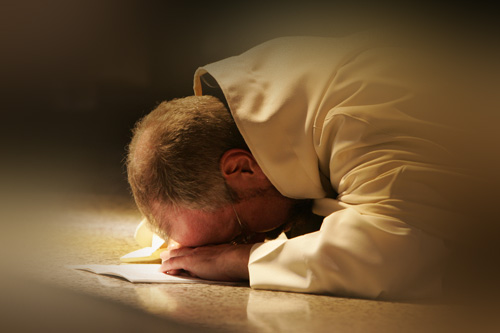In the celebration of Mass we raise our
hearts and minds to God. We are creatures of body as well as spirit, so our
prayer is not confined to our minds and hearts. It is expressed by our bodies
as well. When our bodies are engaged in our prayer, we pray with our whole
person. Using our entire being in prayer helps us to pray with greater
attentiveness. During Mass we assume different postures—standing, kneeling,
sitting—and we are also invited to make a variety of gestures. These postures
and gestures are not merely ceremonial. They have profound meaning and, when
done with understanding, can enhance our participation in the Mass.
STANDING
Standing is a sign of respect and honor,
so we stand as the celebrant who represents Christ enters and leaves the
assembly. From the earliest days of the Church, this posture has been
understood as the stance of those who have risen with Christ and seek the
things that are above. When we stand for prayer, we assume our full stature
before God, not in pride but in humble gratitude for the marvelous things God
has done in creating and redeeming each one of us. By Baptism we have been
given a share in the life of God, and the posture of standing is an
acknowledgment of this wonderful gift. We stand for the proclamation of the
Gospel, which recounts the words and deeds of the Lord. The bishops of the
United States have chosen standing as the posture to be observed for the
reception of Communion.
KNEELING
In the early Church, kneeling signified
penance. So thoroughly was kneeling identified with penance that the early
Christians were forbidden to kneel on Sundays and during the Easter season,
when the prevailing spirit of the Liturgy was one of joy and thanksgiving. In
the Middle Ages kneeling came to signify homage, and more recently this posture
has come to signify adoration, especially before the presence of Christ in the
Eucharist. It is for this reason that the bishops of this country have chosen
the posture of kneeling for the entire Eucharistic Prayer
SITTING
Sitting is the posture of listening and
meditation, so the congregation sits for the pre-Gospel
readings and the homily and may also sit for the period of meditation following
Communion. All should strive to assume a seated posture during the Mass that is
attentive rather than merely at rest.
PROCESSIONS
Every procession in the Liturgy is a
sign of the pilgrim Church, the body of those who believe in Christ, on their
way to the Heavenly Jerusalem. The Mass begins with the procession of the
priest and ministers to the altar. The Book of the Gospels is carried in
procession to the ambo. The gifts of bread and wine are brought forward to the
altar. Members of the assembly come forward in procession—eagerly, attentively,
and devoutly—to receive Holy Communion. We who believe in Christ are moving in
time toward that moment when we will leave this world and enter into the joy of
the Lord in the eternal Kingdom he has prepared for us.
MAKING
THE SIGN OF THE CROSS
We begin and end Mass by marking
ourselves with the Sign of the Cross. Because it was by his death on the Cross
that Christ redeemed humankind, we trace the Sign of the Cross on our
foreheads, lips, and hearts at the beginning of the Gospel, praying that the
Word of God may be always in our minds, on our lips, and in our hearts. The
cross reminds us in a physical way of the Paschal Mystery we celebrate: the
death and Resurrection of our Savior Jesus Christ.
BOWING
Bowing signifies reverence, respect, and
gratitude. In the Creed we bow at the words that commemorate the Incarnation.
We also bow as a sign of reverence before we receive Communion. The priest and
other ministers bow to the altar, a symbol of Christ, when entering or leaving
the sanctuary. As a sign of respect and reverence even in our speech, we bow
our heads at the name of Jesus, at the mention of the Three Persons of the
Trinity, at
the name of the Blessed Virgin Mary, and at the name of the saint whose
particular feast or memorial is being observed.
GENUFLECTING
As a sign of adoration, we genuflect by
bringing our right knee to the floor. Many people also make the Sign of the Cross
as they bend their knee. Traditionally, Catholics genuflect on entering and
leaving church if the Blessed Sacrament is present in the sanctuary of the Church.
The priest and deacon genuflect to the tabernacle on entering and leaving the
sanctuary. The priest also genuflects in adoration after he shows the Body and
Blood of Christ to the people after the consecration and again before inviting the
people to Holy Communion.
ORANS
The priest frequently uses this ancient
prayer posture, extending his hands to his sides, slightly elevated. Orans means
“praying.” Early Christian art frequently depicts the saints and others
standing in this posture, offering their prayers and surrendering themselves,
with hands uplifted to the Lord, in a gesture that echoes Christ’s outstretched
arms as he offered himself on the Cross.
PROSTRATING
In this rarely used posture, an
individual lies full-length on the floor, face to the ground. A posture of deep
humility, it signifies our willingness to share in Christ’s death so as to
share in his Resurrection (see Rom 6). It is used at the beginning of the Celebration
of the Lord’s Passion on Good Friday and also during the Litany of the Saints in
the Rite of Ordination, when those to be ordained deacons, priests, and bishops
prostrate themselves in humble prayer and submission to Christ.
SINGING
“By its very nature song has both an
individual and a communal dimension. Thus, it is no wonder that singing together
in church expresses so well the sacramental presence of God to his people”
(United States Conference of Catholic Bishops, Sing to the Lord, no. 2). As we
raise our voices as one in the prayers, dialogues, and chants of the Mass, most
especially in the Eucharistic Prayer, as well as the other hymns and songs, we
each lend our individual voices to the great hymn of praise and thanksgiving to
the Triune God.
PRAYING
IN UNISON
In the Mass, the worshiping assembly
prays in one voice, speaking or singing together the words of the prayers. By saying
the same words at the same time, we act as what we truly are—one Body united in
Christ through the Sacrament of Baptism.
BEING
SILENT
“Silence in the Liturgy allows the
community to reflect on what it has heard and experienced, and to open its heart
to the mystery celebrated” (Sing to the Lord, no. 118). We gather in silence,
taking time to separate ourselves from the concerns of the world and enter into
the sacred action. We reflect on the readings in silence. We may take time for
silent reflection and prayer after Holy Communion. These times of silence are
not merely times when nothing happens; rather, they are opportunities for us to
enter more deeply in what God is doing in the Mass, and, like Mary, to keep
“all these things, reflecting on them” in our hearts (Lk 2:19).
CONCLUSION
The Church sees in these common postures
and gestures both a symbol of the unity of those who have come together to
worship and also a means of fostering that unity. We are not free to change
these postures to suit our own individual piety, for the Church makes it clear
that our unity of posture and gesture is an expression of our participation in
the one Body formed by the baptized with Christ, our head. When we stand,
kneel, sit, bow, and sign ourselves in common action, we give unambiguous
witness that we are indeed the Body of Christ, united in body, mind, and voice.
REFERENCE
United States Conference of Catholic
Bishops (USCCB). Sing to the Lord: Music in Divine Worship. Pastoral Liturgy
Series 4. Washington, DC: USCCB, 2007.
Scripture texts used in this work are
taken from the New American Bible, copyright © 1991, 1986, and 1970 by the
Confraternity of Christian Doctrine, Washington, DC 20017





No comments:
Post a Comment